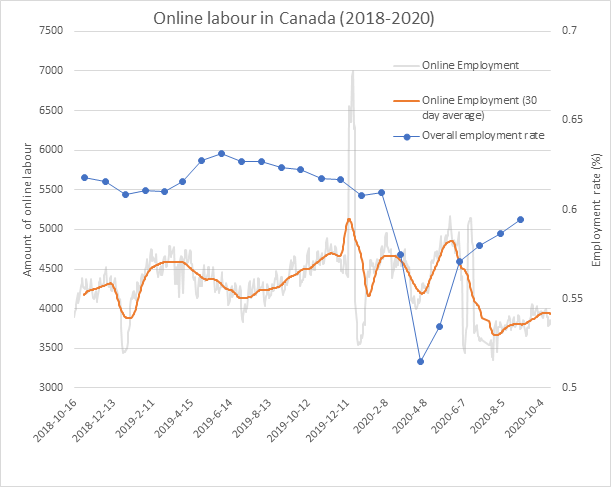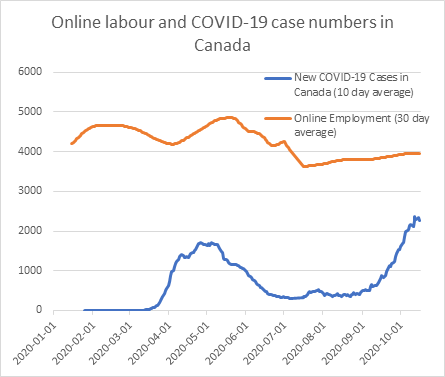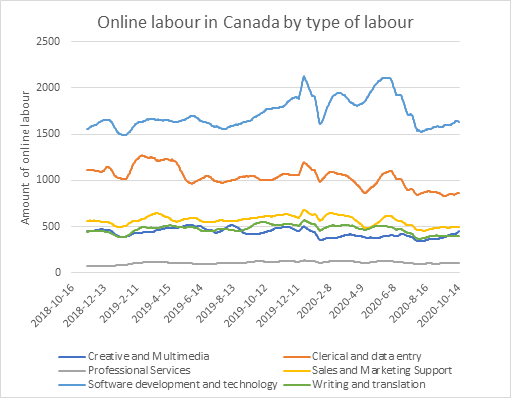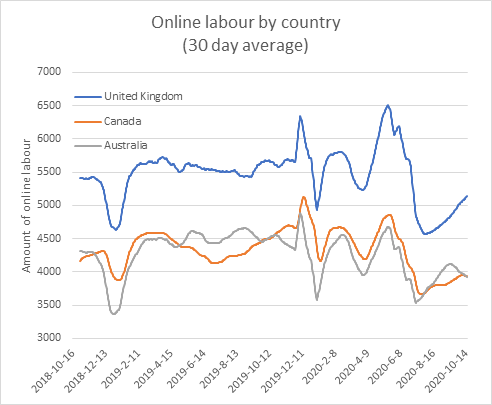Online labour is notoriously difficult to measure. It’s also not an obscure type of work that can be easily disregarded: globally, an estimated (and growing) 48 million people are registered on online work-matching websites,[1] not to mention the millions of people who work online without using a specific platform.
Often performed at irregular hours, sometimes through “microtasks” across a borderless internet, perhaps to earn supplementary income, perhaps only a few times a month — the complexity of online work’s measurement is unsurprising. Traditional labour force measurements, developed well before the widespread proliferation of digital work, are in many ways unfit to respond to such complexity.

Photo by Sergey Zolkin on Unsplash
One response to the problem of measuring digital work is the Oxford Internet Institute’s Online Labour Index (OLI).[2] In near-real time, the index tracks the number of online, freelance tasks being completed, measuring a variety of tasks in countries around the world. The index is simultaneously a logical approach to grappling with evolving patterns of labour and a unique attempt to measure an entire form of work that barely existed just a few years ago.
Still, the OLI is not immune to the complexity of measuring work. Described as “the first economic indicator that provides an online gig economy equivalent of conventional labour market statistics,” the OLI does not measure some forms of work that are usually thought of as gig work, for example, tasks that are organized online but that occur offline, such as driving an Uber or hosting on AirBnb. It also only counts tasks occurring across a select number of English-language websites, meaning that it’s only capturing a particular subset of online labour.
What all of this means for the index and our understanding of online work is that there are, as it stands, many unknowns and many questions worth investigating. How does online work move from country to country? How much do different types of online workers earn? What laws and regulations influence regional differences in online labour? How can you clearly define “online labour,” particularly in the COVID era when so many of us work from home computers?
Despite bringing up so many questions, the OLI can certainly help to teach us some things about online labour — an increasingly important aspect of the modern working world and one that is largely missing from many official estimates, including Canada’s. With this in mind, what does the index say about Canada?
The orange line in Figure 1 depicts online labour posted in Canada since 2018. The last two years saw a clear (though volatile) rise in online labour, at least until the COVID pandemic began to take shape.

Figure 1. Data source: Online Labour Index,[3] Canadian Labour Force Survey (Note: in this and in the following figures, the value on the y-axis represents the number of online job postings within a sample in Canada, not the total number of online job postings, making this a relative, rather than absolute, measure of online labour. These figures also do not normalize the y-axis value, as is done by the Online Labour Index website. Lastly, the data is not seasonally adjusted, meaning that some variations (such as dips in early January) are due partly to seasonal differences in how much people work.)
How does the measure of online labour in Canada relate to the rest of the Canadian economy? As shown in Figure 1, it appears that little comparison can be made between the index values and the Canadian employment rate (in blue). One common answer to this lack of connection is that when people lose “traditional” jobs, they turn to gig work or online tasks as a safety net.[4] Still, the enormous COVID-induced downturn seen in Canadian employment numbers are replicated in the index, if only to a small degree. Interestingly, after the initial downturn in March, a second, larger drop in online labour seems to have occurred over the summer. One possible reason for this is that demand for online work (given its flexible format may address spikes in work demand) has slowed as a result of the general economic downturn.
Comparing online labour to COVID-19 case numbers reveals little, as shown in Figure 2. If online labour in Canada, as measured by the OLI, was impacted by the pandemic, it was certainly less impacted than other, more traditional, forms of labour. This is unsurprising, given that online labour, which is remote by definition, more easily accommodates social distancing protocols.

Figure 2. Data source: Online Labour Index, COVID-19 Canada Open Data Working Group
Each day, the index tracks how many new tasks are posted and completed across several of the world’s largest online work websites, such as Freelancer, Mturk, and Upwork. The index also collects data about the type of tasks being performed on these sites. The complexity of tasks can range significantly: compare, for example, “microtasks” such as tagging photos to a “gig” such as developing a website. In Canada, software development and technology accounts for the largest proportion of tasks being completed. Clerical and data entry work have seen a downward trend in the last two years. Still, the type of work performed most in Canada has changed little over the last two years. Further, Figure 3 below shows that increases and decreases in the number of people doing online work follows a similar pattern across all work categories.

Figure 3. Data source: Online Labour Index
Figure 4 shows that, in the last two years, online work in Canada, the UK, and Australia follows a similar pattern (roughly in proportion to each country’s population), irrespective of geography. Additionally, online work in these countries grew in step until the beginning of 2020. Following several months of volatility, online work dropped to current levels, which are below that of two years ago.

Figure 4. Data source: Online Labour Index
So, what can the index teach us about online labour in Canada? It certainly depends on the questions we ask. The index demonstrates which (English-speaking) countries see the most online labour and which tasks are being performed. Nonetheless, online labour doesn’t seem to correspond much to COVID-19 case numbers or to the employment rate in Canada. This brings up two possibilities: on one hand, online labour may be less like traditional employment than we expect. On the other hand, perhaps the index isn’t truly representative of the state of online labour in Canada. What does seem certain, however, is that the nature of labour is changing before our eyes, and the Online Labour Index itself is an example of the necessary and increasing attention being paid to an evolving world of work.
Notes
[1] Cutean, A., Herron, C., Quan, T. (July 2020). Loading: The Future of Work: Worldwide Remote Work Experimentation and the Evolution of the Platform Economy. Information and Communications Technology Council (ICTC). Ottawa, Canada https://www.ictc-ctic.ca/wp-co…
[2] Kässi, Otto; Vili Lehdonvirta, Online labour index: Measuring the online gig economy for policy and research, Technological Forecasting and Social Change, Volume 137, 2018,
Pages 241–248. [open access version]
[3] Kässi, Otto; Hadley, Charlie; Lehdonvirta, Vili (2019): Online Labour Index: Measuring the Online Gig Economy for Policy and Research. figshare. Dataset. https://doi.org/10.6084/m9.fig…
[4] Cutean, A., Herron, C., Quan, T. (July 2020). Loading: The Future of Work: Worldwide Remote Work Experimentation and the Evolution of the Platform Economy. Information and Communications Technology Council (ICTC). Ottawa, Canada https://www.ictc-ctic.ca/wp-co…
